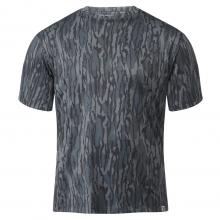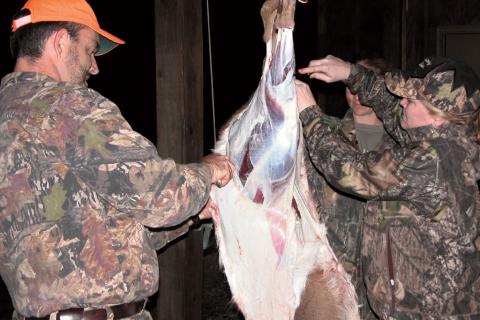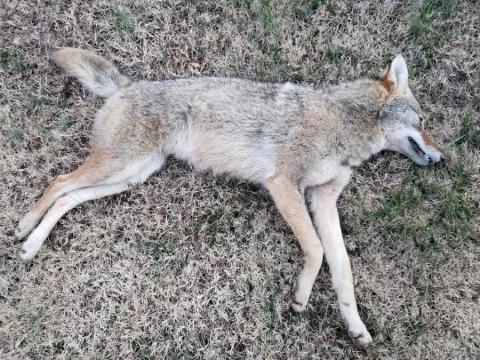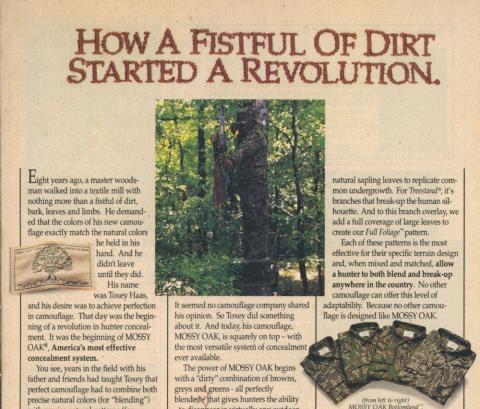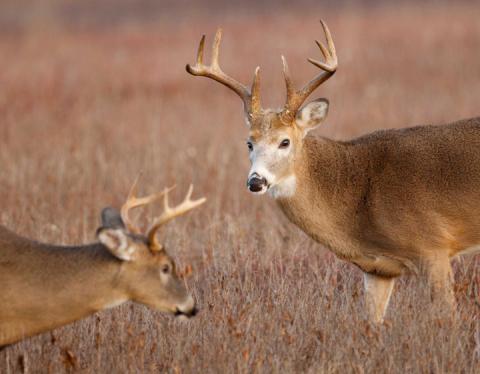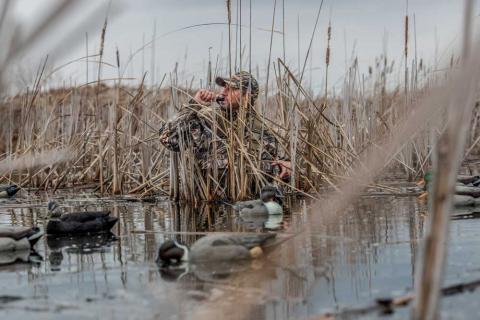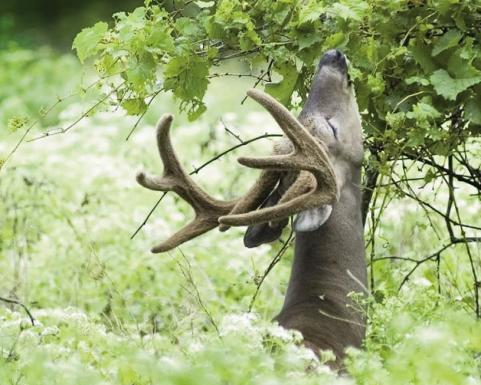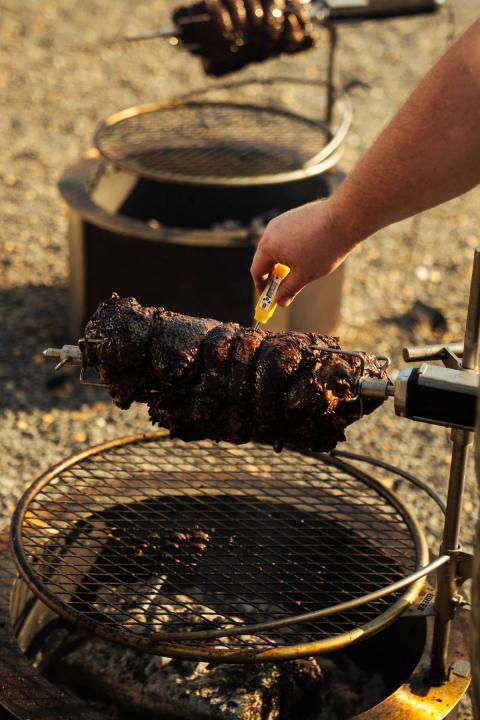
By Terry Madewell, originally published in the 1994 edition of Mossy Oak Bowhunting Magazine
As big whitetail bucks are inclined to do, this one had done the unexpected. I'd studied this buck's pattern for a couple of weeks, being extremely careful not to leave any scent in the wrong places. I'd selected a stand site where the dense underbrush funneled into a 40-yard-wide strip. I was sure this was where he would walk and I would be about 18 feet high in my climbing stand, in perfect position for a 20-yard shot.
The wind was right and my timing was perfect. The only flaw in my hunting strategy was that when I first saw the buck he was stalking through the woods, walking directly toward me, not 20 yards to my left, as expected.
Not surprisingly, as he stopped to check his surroundings, his eyes seemed to lock squarely on my position. He was still 20 yards away and I literally tried to freeze at that moment, even gently closing my eyes. When I peeked a few seconds later expecting to still have his eyes riveted on me, I became wide-eyed in amazement to see that he had not only walked another few yards toward me, but he had turned back in the direction I thought he should have been going originally. A few more steps and he would present a perfect broadside target.
Actually, I shouldn't have seemed surprise that I passed the "close encounter" test. I was using a camo technique referred to by Ronnie Strickland at Mossy Oak as "mix and match," which enables hunters to almost disappear and blend with the woods. Wearing Bottomland pants and a Treestand shirt, I blended so well with my surroundings that I was apparently invisible to the buck. In my opinion, the camo enabled me to get a shot I would otherwise have never been afforded, because experience in the years before I began using Mossy Oak had taught me that the buck would have spotted me in a heartbeat.
One of the real challenges of bowhunting for big bucks is that they often do the unexpected, even when you have the best-laid plan. And unless you can pass the close-encounter test, the game is usually won by the buck. Through proper use of camouflage and various patterns, bowhunters now have an edge they've never had before.
Bob Dixon has been bowhunting whitetails since about 1970, and if those many years of experience have taught him anything, it's that every edge a hunter can get is important.
Get Every Edge You Can

"The more I learn about hunting big whitetail bucks, the more I realize how difficult they are to take with archery equipment," Dixon says. "I work hard at getting every edge I can get, which is no less than what the Indians did before the country was settled. Even with their great woodsman ship skills, they made use of every advantage to get the upper hand on a deer. I certainly intend to do no less."
Dixon's bowhunting experience is not limited to time spent in the field. He's spent his entire career in the sporting goods business (now with Mossy Oak) and has literally devoted his business and leisure time to hunting and outdoor sports.
"One of the most dramatic changes I've noticed during the years I've been hunting is the upgraded camouflage now available to hunters. When I first began hunting, all we had, if we used any camo at all, was the military surplus stuff such as the BDU camo," he recalls.
"Now, however, with the diverse selections available from Mossy Oak, hunters can select from a wide array of patterns and literally match the clothes they wear to the terrain and specific hunting situation they encounter," Dixon adds.
In addition, he says the choices available not only allow a hunter to match his surroundings, but by using the "mix and match" idea a hunter can become almost invisible in the woods.
"I think first, the earth tone colors in the Bottomland pattern are ideal for background camouflage." Dixon says. "This is the basic background for all of our camo patterns and one which blends into almost any hunting environment. Then, when the other patterns such as Treestand, Greenleaf, Full Foliage and Fall Foliage are overlaid on the basic pattern, a hunter can match any season or type of terrain. In addition, he can conform to hunting on the ground of out of a tree stand.
Dixon cites several specific examples of how he changes patterns and mixes and matches to achieve the camo effect that allows him to pass the close-encounter test with big bucks.
Mix-and-Match Specifics

"During the early season of bowhunting in the South, where I hunt, when the season opens we have a lot of leaves still left on the trees," he says. "I use the Full Foliage top to match the limbs and leaves and the Bottomland pants to blend in with the tree trunk. This. helps me become invisible to wary bucks by not only matching my surroundings, but by also breaking my silhouette into two distinct pieces. By mixing and matching my camouflage, I also break up the outline of a human form while blending with the background. There's no doubt that this has enabled me to take several big bucks that otherwise, I believe, would have either spotted me, or at least become highly suspicious of the unusual form in the tree and not allowed me an opportunity to draw my bow," he says.
He adds that later in the season, when the leaves begin to turn color, he switches the Full Foliage top for a Fall Foliage top to continue to blend with the natural background. Still later in the season when the leaves have dropped, he uses the Treestand top with the Bottomland pants as his camo pattern of choice. Another outstanding bowhunter working with Mossy Oak is Steve Burnett, who also strongly endorses mix-and-match patterning and advises hunters that it also works well hunting from the ground.
"There are occasions when hunters need to hunt a specific buck and for reasons associated with his pattern or the type of terrain, they find that hunting from the ground is necessary," Burnett says. "In cases like this, camouflage becomes twice as important to success because you are literally on the deer's level. I'd suggest a mix-and-match pattern which may consist of the Fall Foliage pattern for the bottom, since the dull leaf pattern is usually consistent with the forest floor, and either a Full Foliage, Greenleaf, or Treestand top, depending on the specific season. Since they all have the basic Bottomland background, the basic patterns all blend with one another yet break up the outline of the hunter while fitting the pattern of the surrounding foliage."
As important as quality camo is to the success of the hunt, it is not the answer to successful bowhunting. There are many elements that must work together. Naturally, proper scouting to locate the area bucks are using is key. That's a fairly broad subject and one most hunters understand. There are, however, other specific details which must be considered to be consistently successful. According to Dixon, in bowhunting there are three distinct types of camouflage hunters must learn.
Cover All the Bases

"I'm a big believer that to be successful, a hunter has to camouflage three critical components: scent, sight, and sound. To me, the most important of the three is scent. I realize and understand that camouflage clothing is crucial, and by using the proper camouflage we can fool a buck's eyes. But unless we also hide human scent, we can't fool the animal's nose.
"Early in my hunting career, I learned this lesson the hard way. Although I didn't have the quality camouflage I now have, I made up for it by using natural limbs and leaves to make a blind to shield me. I didn't however, take into account the wind on this particular day. When the buck began to approach my position, I knew I was well hidden and felt I would get a good shot--until I felt the wind gently kiss the back of my neck. Within moments, the buck went fully alert, still out of bow range, and almost retraced his steps as he backed out of the area.
"I learned a valuable lesson that day, and now I will not hunt a stand when the wind is wrong, no matter how hot the deer sign. If you can't have the wind to your advantage to eliminate your scent, then you are doomed to failure," he contends.
I've already covered fooling a deer's eyes in terms of camouflage, but there's another essential "sight" ingredient in the recipe for bowhunting success.
"Unfortunately, some bowhunters forget that even with the perfect camouflage, you still have to be still," Dixon says. "Even gun hunters, who may take deer from 100 to 200 yards or more, have to be conscious of movement. When you hope to get the buck within 20 yards or so for an ideal shot, movement--or actually lack of movement--becomes absolutely crucial.
"Unnatural sounds are also taboo when hunting deer, and although I highly recommend the use of various deer calls, I know that the wrong sound at the wrong time can quickly end a hunt," he says. "A perfect example occurred last year in Texas, where I was hunting near a water hole. The deer were using the spot heavily, but they also seemed to sense that a water hole is a perfect place for an ambush by a predator. As they approached the water hole, they became very alert. It was raining and I had a light rain suit on, but the wind was in my favor and I was well hidden. When I drew the bow on the deer, the rain suit made just the most slight rustling sound, which I thought was so low and indistinct it would be lost in the pattering of the rain. However, the deer heard the sound and took off like he'd been prodded with a hot stick.
"I took off the rain suit, and although my chamois shirt got wet the next buck that came to the water hole never knew I was there and I took him with a 15-yard shot."
Steve Burnett also has several ideas for hunters to consider when hunting bucks.

"Although camouflage is certainly a big part of the overall picture, you must also think in terms of proper scouting as well as various woodsman ship skills such as knowing when to draw on the deer," he says. "Deer have excellent peripheral vision and can see more and better than most hunters realize. Any movement must be slow and steady, and I always try to wait until the deer walks behind a tree or some brush before drawing the bow.
"I also believe learning how to use your eyes to scan the woods without making unnecessary movement is very important. Plus, I feel that training your eyes to 'see' deer in the woods, particularly before they see you, is another key to success."
In addition, Burnett offers other tips well worth considering.
"Regardless of how good an area is, don't hunt from the same tree all season," he advises. "I'll use the same area for sure if plenty of bucks are around, but I'll move from one spot to another so the deer can't lock onto a pattern of my hunting techniques. Once big deer see or smell you, they tend to check that tree thoroughly every time they work through that area. In fact, they sometimes will leave the area for a lengthy time period."
Dixon has a few of his own "do's and don'ts" for bowhunters.
"A lot of things are really common sense, but sometimes we forget them in the excitement of the hunt," he says. "A good example is to never set up in direct sunlight, whether hunting from a tree or on the ground. Get in subdued light or shade, or at least in broken patches of light and shade. Even the best camo pattern and no movement may not hide you when you're in direct sunlight.

"I also recommend using knee-high rubber boots for masking your scent when approaching the stand site," he adds. "I also try to approach the stand site from the opposite direction I think the buck will approach. I addition, I recommend using total camouflage when bowhunting. That includes a hat, headnet, and gloves. As I said earlier, I want every edge I can get and I leave as little to chance as possible.
"When selecting a stand site, I pock a spot where I am not silhouetted against an open sky. I am conscious of having leaves or limbs in the background to help break up my outline and blend with my camo. And I look at using the natural limbs and leaves as part of my total camouflage package."
So if you've mixed and matched your camouflage to the area you're hunting and have taken steps recommended by Dixon and Burnett to fool a buck's senses of smell, sight, and sound, you'll likely discover that you will pass the ultimate "close encounter" test.
And your success rate on whitetails will likely reflect your good grade!







